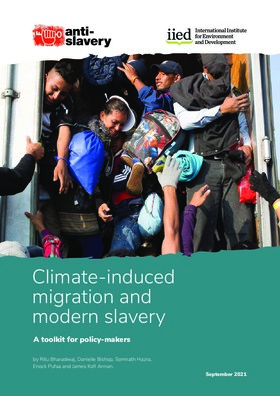🌿 COP 30 - Building a Greener Tomorrow
The 30th UN Climate Change Conference (COP 30) is taking place in Belém, Brazil. Stay informed about global climate actions, negotiations, and live sessions from 10 – 21 November 2025.
Get Updates
Climate-induced migration and modern slavery: A toolkit for policy-makers

Files
Date
January, 2024Author(s)
- Ritu Bharadwaj
- Danielle Bishop
- Somnath Hazra
- Enock Pufaa and James Kofi Annan
Abstract
Contemporary forms of slavery are often categorised as slavery, slavery-like practices, bonded labour, debt bondage and forced sexual exploitation. These are all interrelated and constitute a continuum. According to the Global Estimate of Modern Slavery, 40.3 million people are living in slavery worldwide, which disproportionately affects the most marginalised, such as women, children and minorities. Climate change and climate-induced migration heightens existing vulnerabilities of slavery. Drivers of vulnerability to modern slavery are complex and impacted by many layers of risk. While several socio-economic, political, cultural and institutional risks shape vulnerability, they are increasingly considered to be made worse by climate change impacts and environmental degradation. Climate-induced displacements are becoming unavoidable. The rise of sea levels, salination and flooding are already forcing entire coastal communities – in countries such as the Solomon Islands, Vanuatu and Sierra Leone – to relocate. And as climate shocks are set to intensify, many more millions will be displaced by climate change in the coming decades. The World Bank estimates that by 2050 climate change will force more than 143 million people in sub-Saharan Africa, South Asia and Latin America from their homes. Climate change policies increasingly recognise climate-induced migration and displacement as an issue. The Cancún Adaptation Framework (CAF), adopted during COP16 under the United Nations Framework Convention on Climate Change (UNFCCC) in 2010, provides a conceptual framework to navigate the complexities of climate mobility. CAF recognises three modes of mobility due to climate impacts – migration, displacement and planned relocation – allowing for specific climate policies aligned with the distinct features, mobility patterns and outcomes of each impact.5 In 2015, the Paris Agreement on climate change was an unprecedented development of action on migration and climate with the formal inclusion of ‘migrants’ in its Preamble.
Citation
No citation
Publisher
Anti-Slavery International and International Institute for Environment and Development (IIED)
Rights Holder
Anti-Slavery International and IIED
URI
https://knowledgehub.pksf.org.bd/collections/R1psUFB3UUlWOExUblljamU3ZzIyZz09
